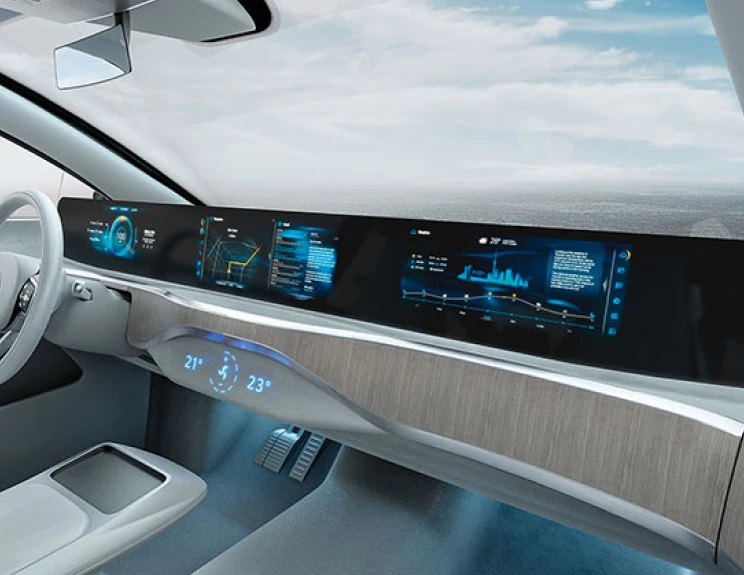
Over the past few years, the electric vehicle (EV) market has experienced a significant surge in demand; this electrifying growth is largely attributed to the development of bespoke software solutions tailored specifically to the industry. As the industry continues to evolve, what can we expect in the new era of software–defined EVs?
A Brief Overview
The demand for electric vehicles (EVs) is increasing globally, regardless of whether they are hybrid, plug-in hybrid or all-electric. According to Canalys' latest research, worldwide sales of EVs grew by a remarkable 49% to 6.2 million units in the first half of 2023 alone, marking a significant increase of 12.4% from the same period last year [1].
By far, mainland China is still the largest market for EVs, accounting for 55% of global EV sales in H1 2023, which translates to a total of 3.4 million units sold. Europe follows as the second-largest market, with a share of 24% and 1.5 million units shipped. While the US only has a 13% market share in global EV sales, it is showing positive signs of growth to become one of the fastest-growing EV markets worldwide, with EVs contributing 97% year-on-year growth, up from 62% in H1 2022 [1].
Beyond these established markets, South Korea, and India have emerged as major forces in the EV sector. India's EV market reached 1.38 million units in Nov 2023, growing 50% YoY [2]. While South Korea's EV market sales are expected to hit 170,000 units and reach $9.2bn by end of 2023 [3].
Main Drivers
Electric vehicles have been around for 100 years, but what's driving the surge in their popularity? The answer is simple: global government initiatives that promote the use of EVs. As part of the Net Zero Emissions by 2050 Scenario - a roadmap for the global energy sector to achieve net zero CO2 emissions by 2050 - governments worldwide are committed to reducing emissions, which has led to increased regulations to phase out petrol and diesel cars.
Take India, home to 14 of the world’s 20 most polluted cities [4]. One of the major causes of this pollution is tailpipe emissions, which is leading the government to push for 30% electric vehicle (EV) adoption by 2030 [5]. To support this goal, the government has introduced a range of policies and incentives at the national and state level, including tax benefits, subsidies, and infrastructure development. For instance, the Faster Adoption and Manufacturing of Electric Vehicles (FAME) scheme, launched in 2015, is a key initiative to promote the use of EVs in the country. The program has an estimated funding of $1.4 billion, which will be used to encourage buyers through financial subsidies [6]. South Korea also introduced myriad incentives to encourage the use of EVs, including tax breaks, financial aid, and investments in R&D. In April 2022, the South Korean government announced a USD 318 million acquisition to strengthen the nation's EV charging and hydrogen refueling networks. This initiative aims to encourage 4.5 million eco-friendly vehicles, including 3.62 million electric vehicles, to operate nationwide by 2030 [7].
The global automotive industry is significantly transforming as it moves towards electric vehicles. Manufacturers are facing increasing pressure to meet customer demands and compete with each other in this highly saturated market. To stay ahead of the curve, companies invest heavily in EV software research and development, preparing themselves for a new era defined by technological innovation. Indeed, the EV software industry is advancing at an incredible speed, with the global market size for EV charging management software expected to grow at a compound annual growth rate of 30.3% from 2023 to 2030 to reach USD 7.50 billion by 2030 [8]. According to recent research by McKinsey, the electronic control unit (ECU) and domain control unit (DCU) are estimated to reach $144 million by 2030. The software development market, which includes integration, verification, and validation, can potentially yield $83 billion in revenue by 2030 [9]. This rapid growth drives a new wave of bespoke EV software development poised to revolutionize the industry.
The road to innovation in the field of EV software seems limitless. What advancements can we expect on this journey?
Charging Forward with EV Software Development
As the electric vehicle industry charges forward a new horizon of technological breakthroughs, these bespoke technologies are driving progress and delivering impactful transformation in the EV software sector.
AI-Powered Vehicle Health Checks
Today, AI is becoming an essential component in EV architecture. AI is particularly useful for monitoring and managing an EV's battery's state of charge (SOC) and state of health (SOH). By gathering sensor data and analyzing anomalies, these systems can determine the vehicle's and its battery's health. This information is invaluable for owners and fleet operators, who can take proactive actions to prevent costly repairs. Additionally, AI systems enable features such as keyless entry, predictive maintenance, remote diagnostics, fleet management, and user-adaptive algorithms to ensure a fully optimized, reliable, and safe EV driving experience.
Improved Connectivity Features
The shift towards software-defined electric vehicles (EVs) highlights the importance of achieving seamless connectivity for a smooth driving experience. To achieve this, the vehicle-to-everything (V2X) technology plays a crucial role in exchanging information between software controllers and internal and external components of the vehicle. This data exchange enables remote diagnostics, location-based services, real-time battery charge monitoring, and over-the-air software updates.
Smart Grids
One challenge that EV owners face is the limited availability of charging stations. That's where smart grids come in. Smart grids offer the necessary visibility and control to mitigate the load impacts and safeguard the distribution network components from overloading by EVs. This ensures that electricity generating capacity is used most efficiently. By enhancing the efficiency of EV charging and load balancing, smart grids provide a seamless charging experience for EV users. Furthermore, innovations like bi-directional charging and vehicle-to-grid (V2G) technology allow EVs to function as energy repositories, which enables more energy optimization.
Advancements in Battery Technology
Many consumers are hesitant to purchase electric vehicles due to their limited mileage. This demand for high-performance EVs with longer mileage is fueling innovation in battery technology. Set to debut in the market in 2030, solid-state batteries with a solid electrolyte and fewer raw materials promise to address all the woes of current lithium-ion batteries. With higher energy density, it can provide long-range, fast charging, a lighter weight, and reduced thermal runaway risk.
ADAS
ADAS is short for Advanced Driver Assistance Systems, a set of technology-based features comprising sensors and controllers. These features aim to improve driving comfort and safety by monitoring the external environment for other vehicles and pedestrians. The information gathered offers real-time suggestions such as emergency braking, intelligent cruise control, and parking assistance.
Toward a New Era
The automotive industry stands at the threshold of a new era, one that is driven by software-defined EVs. By embracing this transformation, automakers can unlock unprecedented levels of performance, safety, efficiency, and connectivity, ultimately leading to a brighter, more sustainable world for all.
To achieve said vision, having a companion is a must, especially when there is an on-going shortage of skilled software engineers specializing in automotive technology. By building a partner network, organizations can leverage the experience, expertise, and proven track record necessary to innovate at lower costs, higher optimization, and shorter product development life cycles. EV leaders can usher in the software-defined era of electric vehicles through this approach, blazing a trail for a transformative future.






























